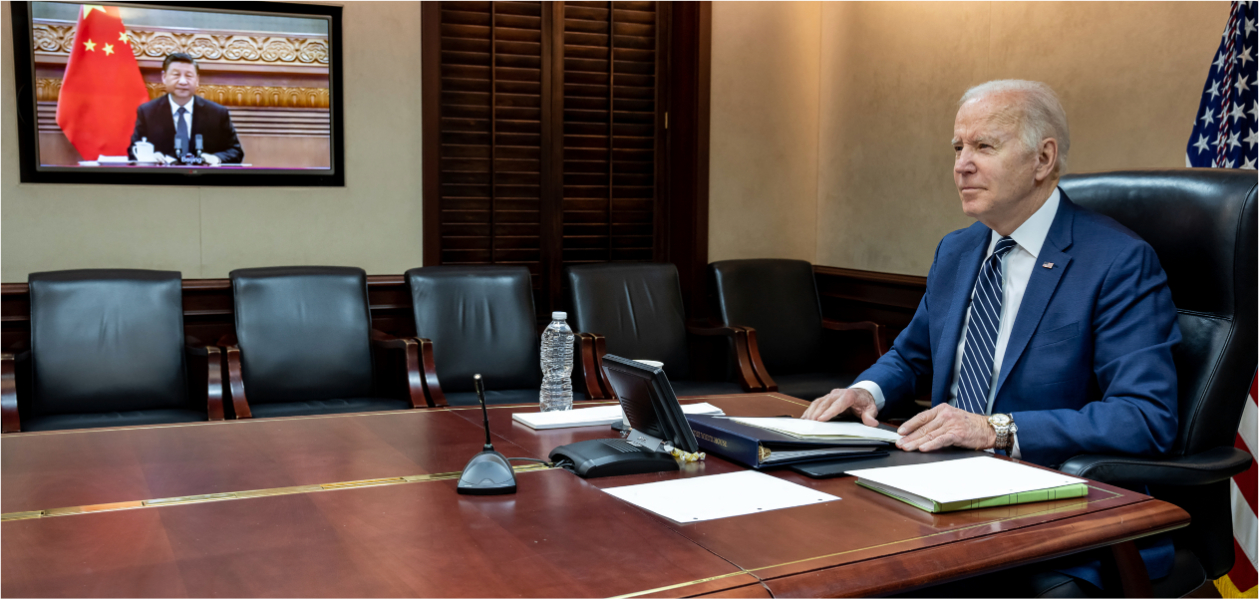
U.S. imperialism is gearing up for years—potentially decades—of confrontation with China and angling to keep Russia in a weakened position. President Joe Biden on Wednesday told the U.S. military and foreign policy establishment to focus on “outcompeting China and restraining Russia” in a new national security strategy document.
Upon taking office, every U.S. presidential administration issues its own national security strategy—the new commander-in-chief’s take on where the U.S. should aim its economic power and armed might. Biden’s declaration, which runs to 48 pages, was expected last December but was held over apparently to await the results of the anticipated Russian invasion of Ukraine.
With the ongoing war between Moscow and Kiev dominating headlines, Russia comes in for the kind of condemnation one would expect in a document like this one. Russia is relegated, however, to the category of an “acute threat” and not seen as a consequential danger to U.S. global dominance.
Instead, it is China on which Biden clearly paints the biggest target. “Russia and the PRC pose different challenges,” the president wrote in his introductory letter, using the acronym for the People’s Republic of China. “The PRC is the only competitor with both the intent to reshape the international order and, increasingly, the economic, diplomatic, military, and technological power to do it.”
Essentially, the administration bemoans the fact that China has become economically developed, built an internationally competitive technology base, and established cooperative trade relations with many nations in the world, especially through its Belt and Road Initiative.

The “international order” China allegedly challenges is the global capitalist economy and military empire that the U.S. has controlled without challenge since the destruction of the Soviet Union over 30 years ago.
The main outlines of contemporary U.S. imperialist strategy have been apparent for some time, especially since the Obama administration’s “pivot to Asia.” It inaugurated the turn of U.S. attention away from the interventions in the Middle East that defined the years leading up to and following 9/11.
The shift toward pinning down China was declared in earnest by then-Secretary of State Hillary Clinton in 2011, when she foretold the beginning of “America’s Pacific Century” in a seminal Foreign Policy article. “The future of politics,” Clinton wrote, “will be decided in Asia, not Afghanistan or Iraq.”
Tangible results of the pivot included the drawdown of the U.S. military’s wars in the Iraq and Afghanistan theaters, the regular deployment of U.S. warships to the Pacific waters near China, the return of U.S. troops to the Philippines, and the encirclement of China with a chain of air bases and naval ports. Chinese naval operations on and around islands in the South China Sea provided the rationale.
Donald Trump put his own aggressive spin on the turn against China, restricting trade and initiating a tariff war on Chinese-made goods. That was followed during the pandemic with the peddling of COVID conspiracy theories that encouraged anti-Asian racism and distracted from his government’s disastrous handling of the coronavirus.
The Biden Doctrine
Now, it’s Biden’s turn. Though his national security strategy is a direct evolution of earlier iterations, the Biden Doctrine is more calculated and explicit in setting the stage for a long Cold War.
The president asserts that China has “ambitions to create an enhanced sphere of influence” in its region. This is deemed inexcusable because the U.S. already views the Indo-Pacific area—like most areas of the world—as its own sphere of influence.
Biden broadcasts the complaints of a U.S. capitalist class long peeved that China won’t phase out socialism and open its major industries to further foreign control and privatization. The document condemns China for benefitting “from the openness of the international economy while limiting access to its domestic market.”
The next ten years will be the “decisive decade,” the strategy predicts, for blocking China “in the technological, economic, political, military, intelligence, and global governance domains.”

The timing of the new national security strategy’s release appears intended to accentuate the attacks on China already appearing in the mainstream media this week. The announcement of the new national security strategy comes just days before the 20th Congress of the Communist Party of China (CPC) opens in Beijing.
The most important political event in the Chinese political calendar, the congress will draft economic policy for the coming years, assess and possibly recommend changes to the country’s COVID-19 mitigation measures, and elect the party’s leadership.
Most predictions are that the new Central Committee chosen by the delegates will opt to renew party General Secretary Xi Jinping’s mandate for a third term, paving the way for his re-election as China’s president. The move would be a break with the recent convention of top Chinese party and state leaders retiring after two terms.
Biden’s accusation on Wednesday that China is plotting to become “the world’s leading power” on Wednesday adds to an avalanche of Western press coverage portraying Xi as a power-hungry dictator in the mold of Mao Zedong or Joseph Stalin. Joining in that narrative, the strategy document says that the U.S. has “profound differences with the Chinese Communist Party and the Chinese Government.”
Pitching U.S. policy as a struggle against authoritarianism, China’s (and Russia’s) “behavior” is characterized as “a challenge to international peace and stability.” They are said to be “waging or preparing for wars of aggression, actively undermining the democratic political processes of other countries, leveraging technology and supply chains for coercion and repression, and exporting an illiberal model of international order.”
While the document points to Russia’s illegal invasion of Ukraine as an example, it also paints China with the same brush—a country that hasn’t been involved in armed conflict with another nation in over 40 years. The U.S.’ tolerance of its own autocratic allies, however—such as Saudi Arabia, which is never mentioned in the document—undermines the argument that promotion of democracy is American foreign policy’s overriding principle.
It is much more likely that Xi’s revival of Marxist ideology in China and his apparent determination to keep the country on the path toward socialism are the things earning the ire of the corporate press and the U.S. government—not concern about democracy within the CPC.
As mentioned, the war in Ukraine provides the convenient point for launching a broadside against Russia, and added to the list of offenses are its 2014 annexation of Crimea, military intervention in Syria, and interference in U.S. elections.
By funneling billions of dollars’ worth of weapons into Ukraine—a policy which the document pledges will continue indefinitely—the Biden administration takes credit for having made Russia’s war “a strategic failure.” It celebrates the fact that the U.S.-led NATO military alliance has been strengthened and expanded thanks to the war.
No mention is made of the long chain of events that foreshadowed the conflict, including the breaking of promises made at the end of the Cold War not to expand NATO, U.S. participation in the coup that replaced the Ukrainian government in 2014, the civil war that has raged in that country since then, and the ethnic oppression carried out in its eastern regions.
Also going unsaid is that the war might have ended in March when Ukraine and Russia were engaged in negotiations which Kiev was ordered to scuttle by British Prime Minister Boris Johnson, allegedly at the behest of the Biden administration. Similarly, the profits that U.S. and other multinational oil and gas companies—along with weapons makers—have made from the war didn’t make the cut for the document’s final version.
Planning the next Cold War
To guarantee a U.S.-dominated order and contain China, the strategy envisions a number of specific steps. First up are major new investments in the already bloated U.S. war machine.
The 2022 U.S. defense budget broke records, coming in at over $838 billion, even more than Biden had requested from Congress. The U.S. spends more on armaments than the next nine major powers combined, and more than three times China. It maintains approximately 750 foreign military bases in more than 80 countries; China operates just five.
The president’s national security strategy will be followed in the coming weeks by the publication of the Pentagon’s own “national defense strategy,” which will make the case for diverting additional U.S. tax dollars toward military spending. Also expected soon is the U.S.’ “nuclear posture review,” a declaration of the Biden administration’s plans for upgrading the country’s nuclear weapons arsenal.
Second, traditional military alliances like NATO will be strengthened further, “particularly on the eastern flank.” Third, new arrangements along the lines of the Australia-U.K.-U.S. (AUKUS) nuclear submarine pact, which is aimed at keeping China hemmed in in the Pacific, will be promoted and expanded. The same will be true of regional agreements like the Indo-Pacific Quad.
In its essence, the Biden administration’s national security strategy is laser-focused on fortifying the encirclement of China that the U.S. has been working to achieve for the past several years. As a secondary goal, it envisions keeping Russia weak by sustaining the fighting in Ukraine and blockading the fragile Russian economy afterward.

As aggressive as the administration’s new Cold War tactics might seem, for some warhawks, they’re still not enough. Kori Schake, a director with the American Enterprise Institute—a right-wing think tank populated by capitalist ideologues—was critical of Biden’s strategy on Wednesday. She told the New York Times that the current military spending plan of the government “does not envision modernization” at the needed speed.
In a Times op-ed last month, she wrote that “the deficiency of the Biden administration’s strategy and its lack of foresight” are to blame for supposed Chinese advances. Schake claimed, “The [U.S.] ships, troop numbers, planes, and missile defenses in the Pacific are a poor match for China’s capability.”
So, the debate in Washington is between different shades of pro-Cold War opinion. Other than a handful of progressives in Congress, there are almost no voices urging détente, cooperation, or disarmament. The U.S. midterm elections are an opportunity to block the even more belligerent Republican caucus from controlling the military budget; but even if the Democrats hold on to power in 2022 and then in 2024, the unacceptable foreign policy status quo will carry on.
It all highlights the weakness of the organized peace movement and the urgent need for the democratic coalitions coming together to fight for progressive domestic policies to add a progressive foreign policy to their agendas. Every dollar spent on weapons is a dollar not spent on health care, education, jobs, housing, and infrastructure.
Related Stories:
> Stopping the new Cold War with China, before it’s too late
> Cooperation with China on climate but conflict elsewhere won’t work

MOST POPULAR TODAY

High Court essentially bans demonstrations, freedom of assembly in Deep South

U.S. imperialism’s ‘ironclad’ support for Israel increases fascist danger at home

UN warns that Israel is still blocking humanitarian aid to Gaza

Resource wars rage in eastern Congo, but U.S. capitalism only sees investment opportunity







Comments